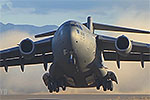Air Force wants more temporary airfields in Eastern Europe, general says
 The Air Force is hoping to remedy its lack of infrastructure in Europe with more modular, small-scale bases and runways, the head of U.S. Air Forces Europe said Tuesday.
The Air Force is hoping to remedy its lack of infrastructure in Europe with more modular, small-scale bases and runways, the head of U.S. Air Forces Europe said Tuesday.
Gen. Frank Gorenc explained that base restructuring under the European Infrastructure Consolidation initiative, which led to the pending closures of RAF Mildenhall, Alconbury and Molesworth, and 12 other installations across Europe, has prompted the Air Force to increase its missions with NATO partners using alternative sites across the continent. The consolidation program, which is expected to save the Pentagon roughly $500 million annually, was announced in 2015.
The pop-up bases are fueled by the European Reassurance Initiative, Gorenc said. If the fiscal 2017 budget request is approved, the services would have $3.4 billion to work with, an increase from $789 million this year.
Designed to allay European partners' fears about Russian aggression in the region, the reassurance initiative, has "allowed us ... to develop airfields, particularly on the eastern side of NATO, the Baltics, Poland, Romania and Bulgaria, and a couple projects elsewhere," Gorenc told reporters at a breakfast Tuesday in Washington, D.C. Those airfields give the Air Force more options to carry out what Gorenc calls " high-volume, high-velocity operations."
The initiative also gives the Air Force the green light to conduct back-to-back — or "heel-to-toe" — training, Gorenc said. Establishing hubs not only with a runway, but also with ramps, fuel and weapons storage provides a viable alternative to generate sorties and combat power "to react" to an adversary. Or, to transport cargo farther east.
For example, three C-130s landed at Lielvarde Air Base, Latvia, on June 17, 2014, the first U.S. Air Force aircraft to land at the renovated installation. During Exercise Saber Strike that year, U.S. and allied airmen tested their ability to open Lielvarde, receive aircraft and develop the base's infrastructure.
The Air Force remains willing to adapt, which is essential given the tumultuous climate near some of Russia's borders.
"Conditions have changed since the [consolidation] study started," Gorenc said. "Crimea broke out, Ukraine broke out, Syria broke out, and the bottom line is, my focus and my concern is to make sure that we have the available infrastructure to accept incoming rotational forces, or, if something happens on the large scale, that we would have the ability to bed down all of the aircraft or any kind of reinforcement that comes into Europe."
The Air Force has proved it can land just about anywhere.
In July, four A-10s from the 354th Expeditionary Fighter Squadron practiced landing at a Polish airfield at Nowe Miasto, a base decommissioned years ago.
"In any area of the world where the U.S. military might be sent, there are multiple austere landing zones that are not normally accessible to many aircraft," said Lt. Col. Ryan Hayde, commander of the 354th Expeditionary Fighter Squadron, reflecting on the mission.
"By demonstrating the U.S. capability to put combat aircraft on a dilapidated runway, in the packed sand or even on dirt, shows that we can increase our reach and put more target sets at risk. It is another example of us being forward, ready, now," he told Air Force Times.